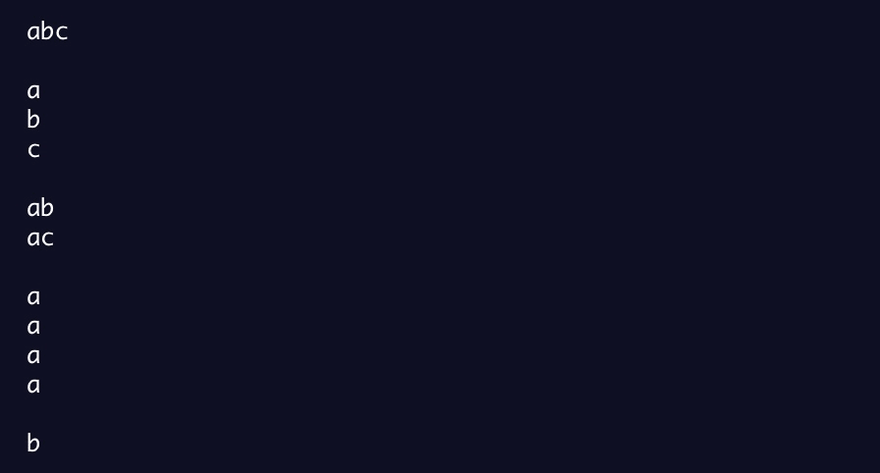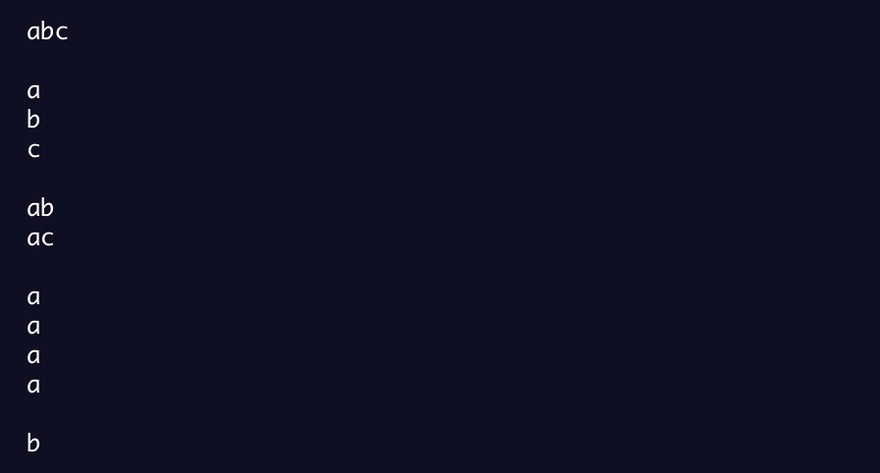Advent of Code 2020 Day 6
Task: Solve for X where...
Part 1:
X = the sum of each group's count of unique questions answered 'yes'
Part 2:
X = the sum of each group's count of shared questions answered 'yes'
Example input
abc
a
b
c
ab
ac
a
a
a
a
b
It represents
- Questions answered 'yes'
- By a single passenger per line
- By a group of passengers separated by empty lines
Part 1
- Is it as simple as counting unique values in a set?
- Yes, it was that simple!
Is it as simple as counting unique values in a set?
Given this group:
abcx
abcy
abcz
Represented as a string:
'abcx\nabcy\nabcz'
With new line characters removed
'abcxabcyabcz'
Split into an array of characters:
['a','b','c','x','a','b','c','y','a','b','c','z']
Each character added to a set of unique values
abcxabcyabcz
++++xxx+xxx+
abcx y z
abcxyz
Return the size of the set
6
Yes, it was that simple!
Split the input at each double-new-line character to generate an array of strings
For each string, accumulate a sum - starting from 0
Add to the sum the result of these operations:
Remove any new-line characters in the current string
Split the string into an array of characters
For each character, accumulate a unique set of values - starting empty
Attempt to add the current character to the set
Return the set containing all unique characters added
Return the size of the unique set
Return the sum of all set sizes
Here's that algorithm written in JavaScript
- a stands for accumulator
- c stands for current
input
.split('\n\n')
.reduce((a,c) => a += c
.replaceAll('\n','')
.split('')
.reduce((a,c) => a.add(c), new Set()).size
,0)
Here's a visualization of that algorithm

Part 2
Refactoring Part 1 in a jiffy
Split the input at each double-new-line character to generate an array of strings
For each string, accumulate a sum - starting from 0
Add to the sum the result of these operations:
Store as the variable, groups:
Split each string at the new-line character to create an array of strings
Split each string into an array of characters
Checking only the first array in groups:
For each character, accumulate a unique set of values - starting empty
If the character exists in each of the arrays inside groups
Attempt to add the current character to the set
Return the set containing all unique characters added
Return the size of the unique set
Return the sum of all set sizes
Here's my algorithm written in JavaScript
stream
.split('\n\n')
.reduce(
(a1, c1) => {
let groups = c1
.split('\n')
.map(el => el.split(''))
return a1 += groups[0]
.reduce(
(a2,c2) => groups.every(i => i.includes(c2))
? a2.add(c2)
: a2, new Set()
)
.size
}, 0)
Here's a visualization of my algorithm

That puzzle felt easy.
Which is proof of how much I've learned.
Because I recall skipping this puzzle nearly a year ago when I first skimmed the instructions.
Hooray for the demonstrable feeling of self-improvement and accomplishment!



Top comments (0)